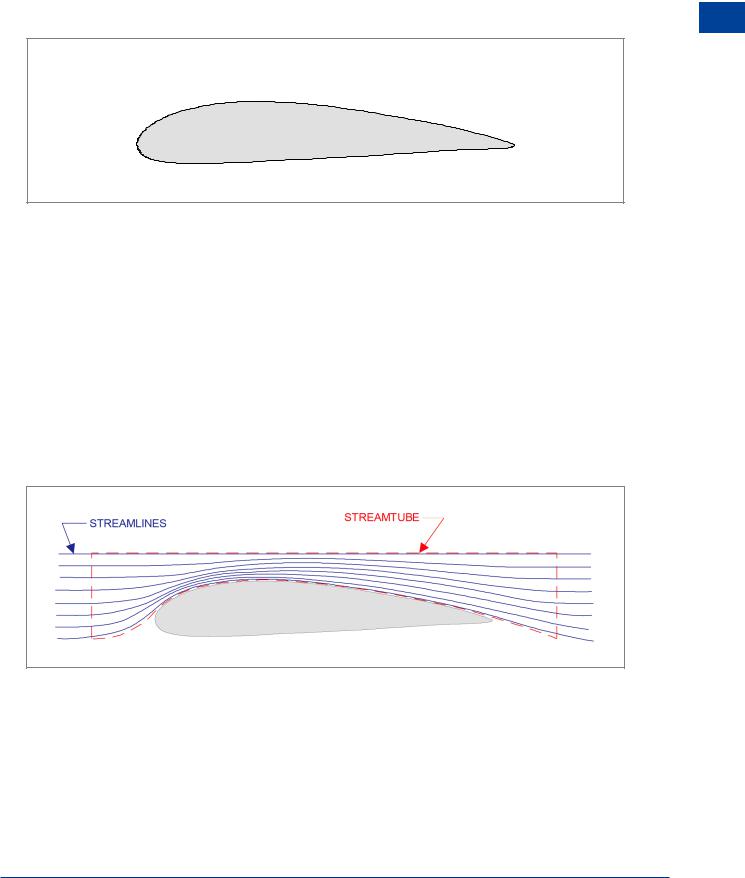
- •Textbook Series
- •Contents
- •1 Overview and Definitions
- •Overview
- •General Definitions
- •Glossary
- •List of Symbols
- •Greek Symbols
- •Others
- •Self-assessment Questions
- •Answers
- •2 The Atmosphere
- •Introduction
- •The Physical Properties of Air
- •Static Pressure
- •Temperature
- •Air Density
- •International Standard Atmosphere (ISA)
- •Dynamic Pressure
- •Key Facts
- •Measuring Dynamic Pressure
- •Relationships between Airspeeds
- •Airspeed
- •Errors and Corrections
- •V Speeds
- •Summary
- •Questions
- •Answers
- •3 Basic Aerodynamic Theory
- •The Principle of Continuity
- •Bernoulli’s Theorem
- •Streamlines and the Streamtube
- •Summary
- •Questions
- •Answers
- •4 Subsonic Airflow
- •Aerofoil Terminology
- •Basics about Airflow
- •Two Dimensional Airflow
- •Summary
- •Questions
- •Answers
- •5 Lift
- •Aerodynamic Force Coefficient
- •The Basic Lift Equation
- •Review:
- •The Lift Curve
- •Interpretation of the Lift Curve
- •Density Altitude
- •Aerofoil Section Lift Characteristics
- •Introduction to Drag Characteristics
- •Lift/Drag Ratio
- •Effect of Aircraft Weight on Minimum Flight Speed
- •Condition of the Surface
- •Flight at High Lift Conditions
- •Three Dimensional Airflow
- •Wing Terminology
- •Wing Tip Vortices
- •Wake Turbulence: (Ref: AIC P 072/2010)
- •Ground Effect
- •Conclusion
- •Summary
- •Answers from page 77
- •Answers from page 78
- •Questions
- •Answers
- •6 Drag
- •Introduction
- •Parasite Drag
- •Induced Drag
- •Methods of Reducing Induced Drag
- •Effect of Lift on Parasite Drag
- •Aeroplane Total Drag
- •The Effect of Aircraft Gross Weight on Total Drag
- •The Effect of Altitude on Total Drag
- •The Effect of Configuration on Total Drag
- •Speed Stability
- •Power Required (Introduction)
- •Summary
- •Questions
- •Annex C
- •Answers
- •7 Stalling
- •Introduction
- •Cause of the Stall
- •The Lift Curve
- •Stall Recovery
- •Aircraft Behaviour Close to the Stall
- •Use of Flight Controls Close to the Stall
- •Stall Recognition
- •Stall Speed
- •Stall Warning
- •Artificial Stall Warning Devices
- •Basic Stall Requirements (EASA and FAR)
- •Wing Design Characteristics
- •The Effect of Aerofoil Section
- •The Effect of Wing Planform
- •Key Facts 1
- •Super Stall (Deep Stall)
- •Factors that Affect Stall Speed
- •1g Stall Speed
- •Effect of Weight Change on Stall Speed
- •Composition and Resolution of Forces
- •Using Trigonometry to Resolve Forces
- •Lift Increase in a Level Turn
- •Effect of Load Factor on Stall Speed
- •Effect of High Lift Devices on Stall Speed
- •Effect of CG Position on Stall Speed
- •Effect of Landing Gear on the Stall Speed
- •Effect of Engine Power on Stall Speed
- •Effect of Mach Number (Compressibility) on Stall Speed
- •Effect of Wing Contamination on Stall Speed
- •Warning to the Pilot of Icing-induced Stalls
- •Stabilizer Stall Due to Ice
- •Effect of Heavy Rain on Stall Speed
- •Stall and Recovery Characteristics of Canards
- •Spinning
- •Primary Causes of a Spin
- •Phases of a Spin
- •The Effect of Mass and Balance on Spins
- •Spin Recovery
- •Special Phenomena of Stall
- •High Speed Buffet (Shock Stall)
- •Answers to Questions on Page 173
- •Key Facts 2
- •Questions
- •Key Facts 1 (Completed)
- •Key Facts 2 (Completed)
- •Answers
- •8 High Lift Devices
- •Purpose of High Lift Devices
- •Take-off and Landing Speeds
- •Augmentation
- •Flaps
- •Trailing Edge Flaps
- •Plain Flap
- •Split Flap
- •Slotted and Multiple Slotted Flaps
- •The Fowler Flap
- •Comparison of Trailing Edge Flaps
- •and Stalling Angle
- •Drag
- •Lift / Drag Ratio
- •Pitching Moment
- •Centre of Pressure Movement
- •Change of Downwash
- •Overall Pitch Change
- •Aircraft Attitude with Flaps Lowered
- •Leading Edge High Lift Devices
- •Leading Edge Flaps
- •Effect of Leading Edge Flaps on Lift
- •Leading Edge Slots
- •Leading Edge Slat
- •Automatic Slots
- •Disadvantages of the Slot
- •Drag and Pitching Moment of Leading Edge Devices
- •Trailing Edge Plus Leading Edge Devices
- •Sequence of Operation
- •Asymmetry of High Lift Devices
- •Flap Load Relief System
- •Choice of Flap Setting for Take-off, Climb and Landing
- •Management of High Lift Devices
- •Flap Extension Prior to Landing
- •Questions
- •Annexes
- •Answers
- •9 Airframe Contamination
- •Introduction
- •Types of Contamination
- •Effect of Frost and Ice on the Aircraft
- •Effect on Instruments
- •Effect on Controls
- •Water Contamination
- •Airframe Aging
- •Questions
- •Answers
- •10 Stability and Control
- •Introduction
- •Static Stability
- •Aeroplane Reference Axes
- •Static Longitudinal Stability
- •Neutral Point
- •Static Margin
- •Trim and Controllability
- •Key Facts 1
- •Graphic Presentation of Static Longitudinal Stability
- •Contribution of the Component Surfaces
- •Power-off Stability
- •Effect of CG Position
- •Power Effects
- •High Lift Devices
- •Control Force Stability
- •Manoeuvre Stability
- •Stick Force Per ‘g’
- •Tailoring Control Forces
- •Longitudinal Control
- •Manoeuvring Control Requirement
- •Take-off Control Requirement
- •Landing Control Requirement
- •Dynamic Stability
- •Longitudinal Dynamic Stability
- •Long Period Oscillation (Phugoid)
- •Short Period Oscillation
- •Directional Stability and Control
- •Sideslip Angle
- •Static Directional Stability
- •Contribution of the Aeroplane Components.
- •Lateral Stability and Control
- •Static Lateral Stability
- •Contribution of the Aeroplane Components
- •Lateral Dynamic Effects
- •Spiral Divergence
- •Dutch Roll
- •Pilot Induced Oscillation (PIO)
- •High Mach Numbers
- •Mach Trim
- •Key Facts 2
- •Summary
- •Questions
- •Key Facts 1 (Completed)
- •Key Facts 2 (Completed)
- •Answers
- •11 Controls
- •Introduction
- •Hinge Moments
- •Control Balancing
- •Mass Balance
- •Longitudinal Control
- •Lateral Control
- •Speed Brakes
- •Directional Control
- •Secondary Effects of Controls
- •Trimming
- •Questions
- •Answers
- •12 Flight Mechanics
- •Introduction
- •Straight Horizontal Steady Flight
- •Tailplane and Elevator
- •Balance of Forces
- •Straight Steady Climb
- •Climb Angle
- •Effect of Weight, Altitude and Temperature.
- •Power-on Descent
- •Emergency Descent
- •Glide
- •Rate of Descent in the Glide
- •Turning
- •Flight with Asymmetric Thrust
- •Summary of Minimum Control Speeds
- •Questions
- •Answers
- •13 High Speed Flight
- •Introduction
- •Speed of Sound
- •Mach Number
- •Effect on Mach Number of Climbing at a Constant IAS
- •Variation of TAS with Altitude at a Constant Mach Number
- •Influence of Temperature on Mach Number at a Constant Flight Level and IAS
- •Subdivisions of Aerodynamic Flow
- •Propagation of Pressure Waves
- •Normal Shock Waves
- •Critical Mach Number
- •Pressure Distribution at Transonic Mach Numbers
- •Properties of a Normal Shock Wave
- •Oblique Shock Waves
- •Effects of Shock Wave Formation
- •Buffet
- •Factors Which Affect the Buffet Boundaries
- •The Buffet Margin
- •Use of the Buffet Onset Chart
- •Delaying or Reducing the Effects of Compressibility
- •Aerodynamic Heating
- •Mach Angle
- •Mach Cone
- •Area (Zone) of Influence
- •Bow Wave
- •Expansion Waves
- •Sonic Bang
- •Methods of Improving Control at Transonic Speeds
- •Questions
- •Answers
- •14 Limitations
- •Operating Limit Speeds
- •Loads and Safety Factors
- •Loads on the Structure
- •Load Factor
- •Boundary
- •Design Manoeuvring Speed, V
- •Effect of Altitude on V
- •Effect of Aircraft Weight on V
- •Design Cruising Speed V
- •Design Dive Speed V
- •Negative Load Factors
- •The Negative Stall
- •Manoeuvre Boundaries
- •Operational Speed Limits
- •Gust Loads
- •Effect of a Vertical Gust on the Load Factor
- •Effect of the Gust on Stalling
- •Operational Rough-air Speed (V
- •Landing Gear Speed Limitations
- •Flap Speed Limit
- •Aeroelasticity (Aeroelastic Coupling)
- •Flutter
- •Control Surface Flutter
- •Aileron Reversal
- •Questions
- •Answers
- •15 Windshear
- •Introduction (Ref: AIC 84/2008)
- •Microburst
- •Windshear Encounter during Approach
- •Effects of Windshear
- •“Typical” Recovery from Windshear
- •Windshear Reporting
- •Visual Clues
- •Conclusions
- •Questions
- •Answers
- •16 Propellers
- •Introduction
- •Definitions
- •Aerodynamic Forces on the Propeller
- •Thrust
- •Centrifugal Twisting Moment (CTM)
- •Propeller Efficiency
- •Variable Pitch Propellers
- •Power Absorption
- •Moments and Forces Generated by a Propeller
- •Effect of Atmospheric Conditions
- •Questions
- •Answers
- •17 Revision Questions
- •Questions
- •Answers
- •Explanations to Specimen Questions
- •Specimen Examination Paper
- •Answers to Specimen Exam Paper
- •Explanations to Specimen Exam Paper
- •18 Index

Basic AerodynamicTheory |
|
3 |
|
||
|
|
|
The tubes illustrated above are used only to demonstrate the principle of continuity and Bernoulli’s theorem and are of no practical use in making an aeroplane fly.
But an aerodynamic force to oppose the weight of an aircraft can be generated by using a specially shaped body called an aerofoil.
Basic Aerodynamic Theory 3
Figure 3.3 Typical aerofoil section
The airflow velocity over the top surface of a lifting aerofoil will be greater than that beneath, so the pressure differential that results will produce a force per unit area acting upwards. The larger the surface area, the bigger the force that can be generated.
In the next section we see that the flow over the top of the aerofoil looks very like the tube on the opposite page and the principle of continuity and Bernoulli’s theorem still apply.
Streamlines and the Streamtube
A streamline is the path traced by a particle of air in a steady airflow, and streamlines cannot cross. When streamlines are shown close together it illustrates increased velocity, and vice versa. Diverging streamlines illustrate a decelerating airflow and resultant increasing pressure, and converging streamlines illustrate an accelerating airflow, with resultant decreasing pressure.
Figure 3.4 Streamlines & a streamtube
A streamtube is an imaginary tube made of streamlines. There is no flow into or out of the streamtube through the “walls”, only a flow along the tube. With this concept it is possible to visualize the airflow around an aerofoil being within a tube made up of streamlines.
45

3 |
|
Basic AerodynamicTheory |
|
||
|
|
|
Theory Aerodynamic Basic 3
Summary
At flow speeds of less than about M 0.4, pressure changes will not affect air density.
Continuity:
•Air accelerates when the cross-sectional area of a streamline flow is reduced.
•Air decelerates when the cross-sectional area increases again.
Bernoulli:
•If a streamline flow of air accelerates, its kinetic energy will increase and its static pressure will decrease.
•When air decelerates, the kinetic energy will decrease and the static pressure will increase again.
By harnessing the principle of continuity and Bernoulli’s theorem an aerodynamic force can be generated.
46

|
|
Questions |
|
3 |
|
Questions |
|
||||
|
|
|
|
||
1. |
If the cross-sectional area of an airflow is mechanically reduced: |
|
|
|
|
|
a. |
the velocity of the airflow remains constant and the kinetic energy increases. |
3 |
||
|
b. |
the velocity of the airflow remains constant and the mass flow increases. |
|
Questions |
|
|
c. |
the mass flow remains constant and the static pressure increases. |
|
||
|
|
|
|
||
|
d. |
the mass flow remains constant and the velocity of the airflow increases. |
|
|
|
2. |
The statement, Pressure plus Kinetic energy equals constant, refers to: |
|
|
|
|
|
a. |
Bernoulli’s theorem. |
|
|
|
|
b. |
the principle of continuity. |
|
|
|
|
c. |
Newton’s second law of motion. |
|
|
|
|
d. |
the Magnus effect. |
|
|
|
3. |
If the velocity of an air mass is increased: |
|
|
|
|
|
a. |
the dynamic pressure will decrease and the static pressure will increase. |
|
|
|
|
b. |
the static pressure will remain constant and the kinetic energy will increase. |
|
|
|
|
c. |
the kinetic energy will increase, the dynamic pressure will increase and the |
|
|
|
|
|
static pressure will decrease. |
|
|
|
|
d. |
the mass flow will stay constant, the dynamic pressure will decrease and the |
|
|
|
|
|
static pressure will increase. |
|
|
|
4. |
When considering a streamlined airflow, which of the following statements is |
|
|
|
|
|
correct? |
|
|
|
|
|
1. |
A resultant decrease in static pressure is indicated by streamlines shown |
|
|
|
|
|
close together. |
|
|
|
|
2. |
An increase in velocity is indicated by streamlines shown close together. |
|
|
|
|
3. |
Accelerating airflow with a resultant decreasing static pressure is indicated |
|
|
|
|
|
by converging streamlines. |
|
|
|
|
4. |
Diverging streamlines indicate decelerating airflow with a resultant |
|
|
|
|
|
increasing static pressure. |
|
|
|
|
a. |
2 and 4. |
|
|
|
|
b. |
1, 3 and 4. |
|
|
|
|
c. |
2, 3 and 4. |
|
|
|
|
d. |
1, 2, 3 and 4. |
|
|
|
5. |
If the pressure on one side of a surface is lower than on the other side: |
|
|
|
|
|
a. |
a force per unit area will exist, acting in the direction of the lower pressure. |
|
|
|
|
b. |
no force will be generated, other than drag. |
|
|
|
|
c. |
a force will be generated, acting in the direction of the higher pressure. |
|
|
|
|
d. |
the pressure will leak around the sides of the surface, cancelling out any |
|
|
|
|
|
pressure differential. |
|
|
|
47

|
3 |
|
Questions |
|
||
6. |
When considering a streamtube, which of the following statements is correct? |
|||||
|
|
|
||||
|
|
|
|
1. |
Different sizes of stream tube are manufactured to match the wingspan of |
|
|
|
|
|
|
the aircraft to which they will be fitted. |
|
3 |
|
|
2. |
A streamtube is a concept to aid understanding of aerodynamic force |
||
|
|
|
|
|
generation. |
|
Questions |
|
3. |
There is no flow into or out of the streamtube through the “walls”, only |
|||
|
4. |
A streamtube is an imaginary tube made up of streamlines. |
||||
|
|
|
|
|
flow along the tube. |
|
a.1 only.
b.1 and 3.
c.2, 3 and 4.
d.1, 2 and 3.
7.In accordance with the principle of continuity:
1.air accelerates when the cross-sectional area of a streamline flow is reduced.
2.when air accelerates the density of air in a streamline flow is increased.
3.air decelerates when the cross-sectional area of a streamline flow is increased.
4.changes in cross-sectional area of a streamline flow will affect the air velocity.
Which of the preceding statements are true?
a.1, 2, 3 and 4.
b.1 and 4.
c.3 and 4.
d.1, 3 and 4.
8.In accordance with Bernoulli’s theorem:
1.if a streamline flow of air decelerates, its kinetic energy will decrease and the static pressure will increase.
2.if a streamline flow of air accelerates, its kinetic energy will increase and the static pressure will decrease.
3.if a streamline flow of air is accelerated, the dynamic pressure will increase and the static pressure will increase.
4.if a streamline flow of air is decelerated, its dynamic pressure will decrease and the static pressure will increase.
The combination of correct statements is:
a.1, 2, 3 and 4.
b.3 only.
c.1, 2 and 4.
d.3 and 4.
9.The statement, “Energy and mass can neither be created nor destroyed, only changed from one form to another”, refers to:
a.Bernoulli’s theorem.
b.the equation of kinetic energy.
c.the principle of continuity.
d.Bernoulli’s principle of continuity.
48

Questions 3
Questions 3
49
